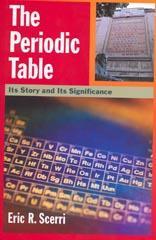Gordan Woods reviews this guide to the periodic table
The periodic table: its story and its significance
Eric R. Scerri
Oxford
OUP 2007 | 346pp | £19.99
ISBN 0195305736
This hardback is protected by an attractive coloured cover with on the front the Mendeleev statue and birth centenary giant periodic table in St Petersburg and on the back laudatory comments from John Emsley, Peter Atkins and Jan van Spronsen, celebrated authors of previous periodic table books. However, the quality is not merely skin deep, there is real scholarship inside.
The book is dedicated to the author's parents and to the centenary of the death of Dmitri Mendeleev. It is odd therefore that there are no details of the Russian chemist's death or any obituary. The book is logically structured, starting with an overview of the periodic table, followed by aspects of the element nomenclature, leading to a chronological critical description of various chemists fumbling towards the periodic system with its full revelation by Mendeleev and its acceptance by others later in the 19th century.
The second half of the book brings the reader up to date with the relation of the periodic table to electronic structure, quantum mechanics and other subjects such as astrophysics and cosmology. Scerri frequently brings in his commitment to the philosophy of science by discussing the historical development of the concepts of the element and fundamental material and ideas of pluralism and reductionism.
There are plenty of monochrome portraits, diagrams and tables which help to make the text more digestible. The text is that of a cultured scholar, some of which has appeared in his previous publications. Although published by the Oxford University Press, the book is from its New York Office hence the American spellings. There are 40 pages of smaller print endnotes which amplify the main text and identify the original sources. This involves a huge amount of detail which does, understandably, have some minor errors. I particularly liked some of the author's summary tables such as Mendeleev's right and wrong element predictions, the element discovery timeline with links to Periodic people and numerous tables redrawn for greater clarity.
Serious students of the periodic table or of chemical history will buy their own copy of The periodic table: its story and its significance. Teachers should try to get a copy in the staff library and use excerpts to ask questions of and answer queries from interested pupils. I would have been proud to have written this book rather than just contributing one image.
Purchase The periodic table: its story and its significance from Amazon.co.uk







1 Reader's comment